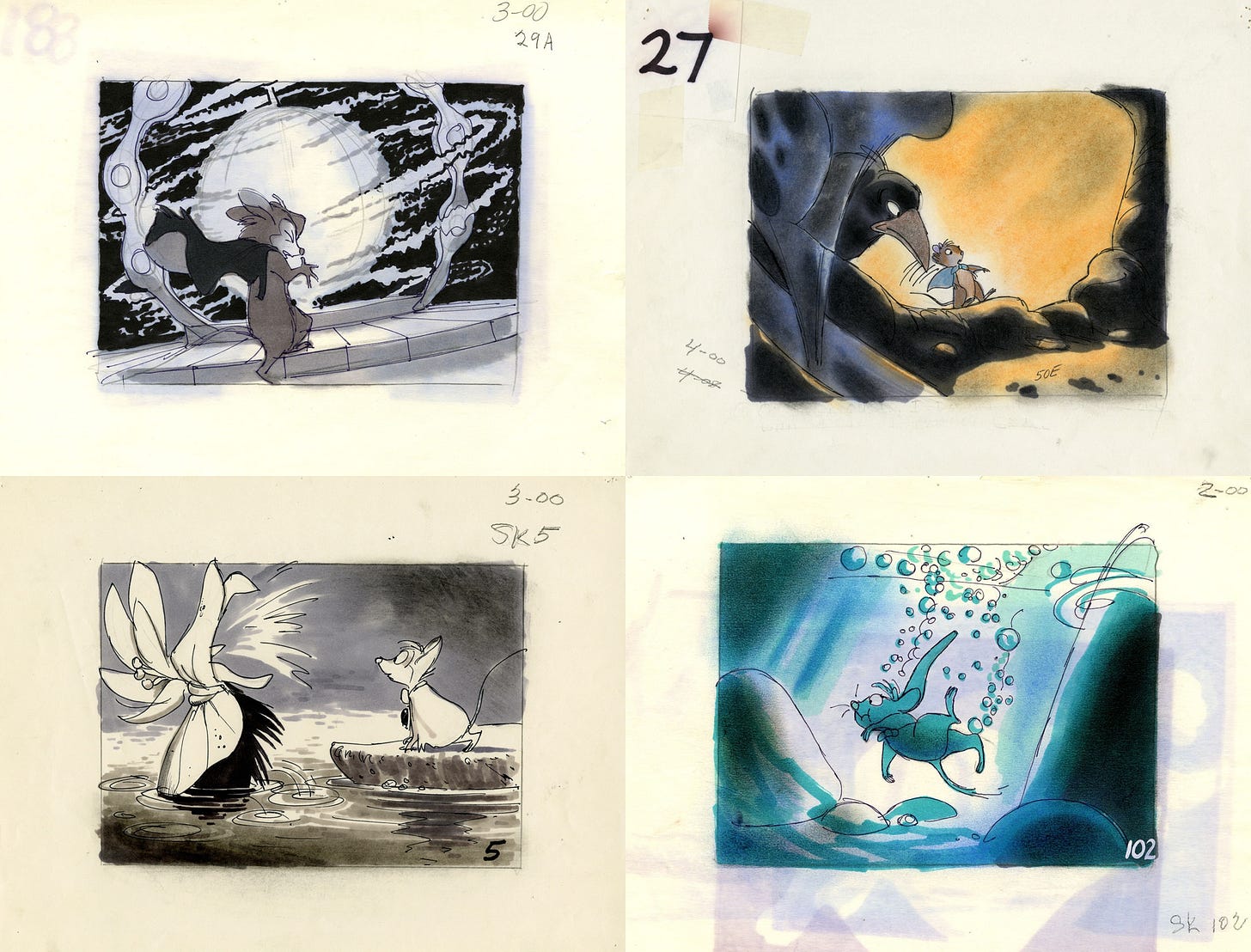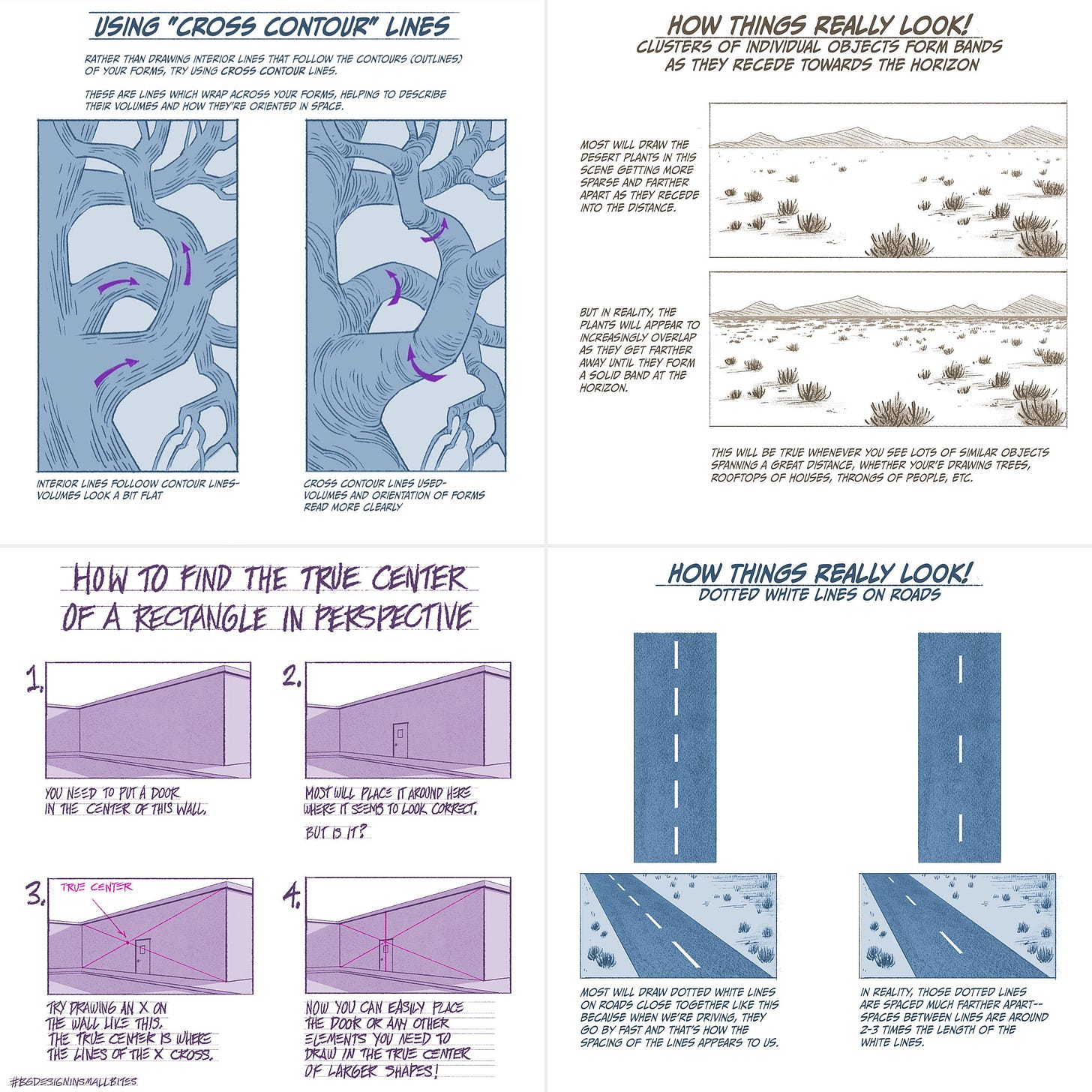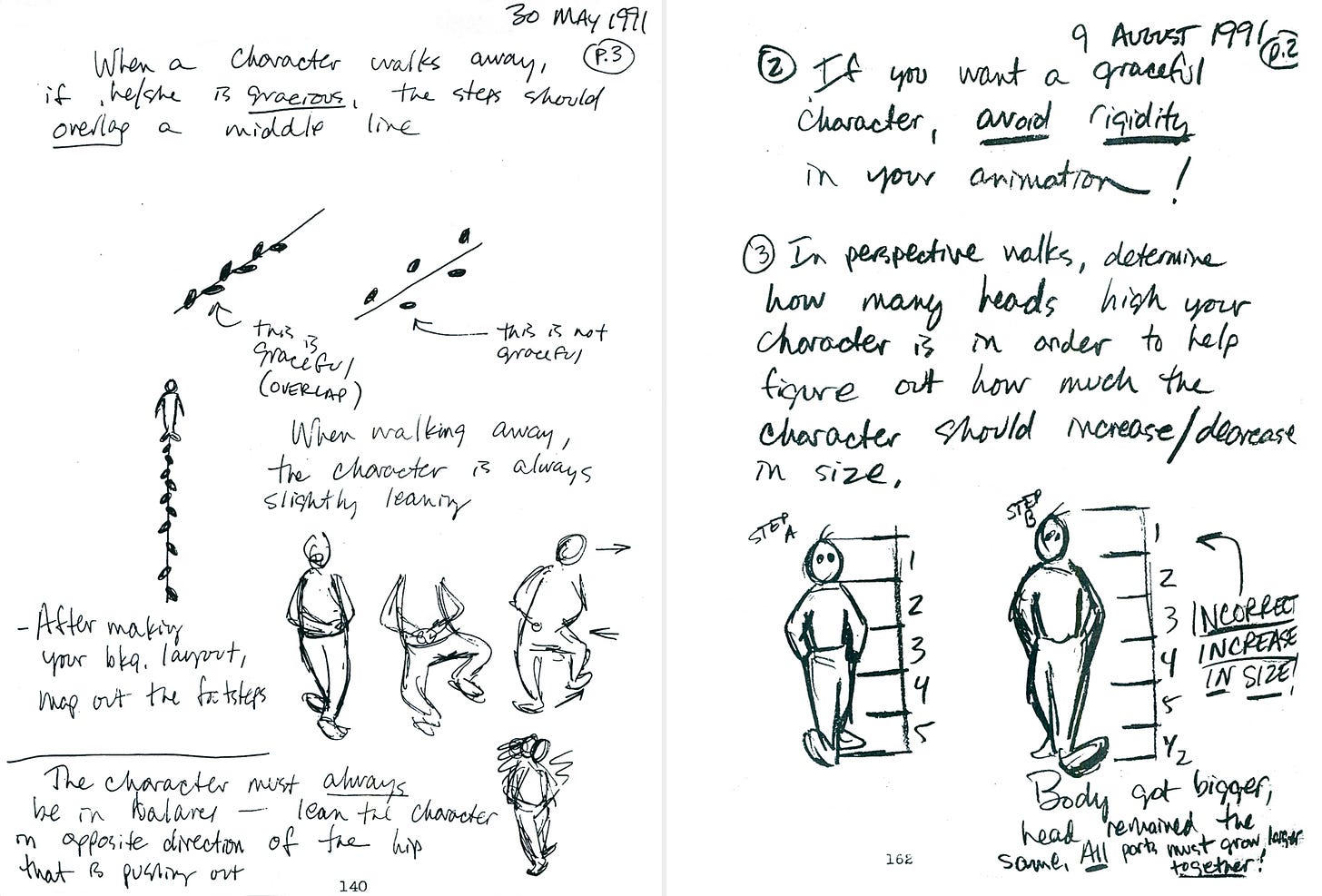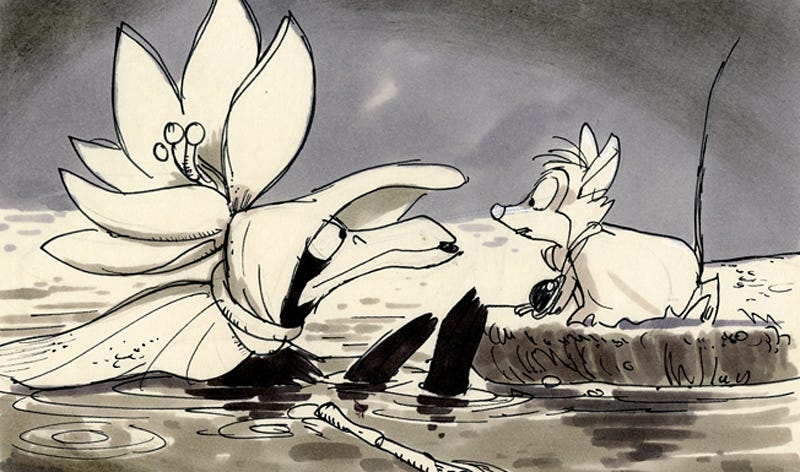Welcome back! It’s a new Sunday edition of the Animation Obsessive newsletter, and this is the plan:
1️⃣ Free resources for artists.
2️⃣ The world’s animation news.
For those just finding us — it’s free to sign up for our Sunday issues. You’ll get them weekly in your inbox:
Now, we’re off!
1: Five treasure troves
Many of our readers are artists. You might be one yourself. We love to uncover the process of art — and it turns out that lots of people (there are more than 17,000 of you now!) share that passion. Artists in our readership have told us that stuff we highlight directly affects their own work, too, which is wonderful.
It’s something we keep in mind. Every so often, we run across a trove of free information that isn’t just a good source for a newsletter story: it’s rich enough to stand alone as an educational resource for artists. When we find one, we save it back. In 2022, we highlighted six of these resources. Since then, we’ve gathered a new batch — which we’re sharing today.
It’s a varied list, and not exclusive to animation. Anyone involved in art (newcomer or pro, animator or not) will likely find something of value below. In fact, you might know a few of these already. We hope you’ll enjoy!
1. The Don Bluth Collection
First on our list is an archive that seems almost too good to be free. It’s the Don Bluth Collection of Animation, hosted by SCAD.
Bluth and associates donated tons of drawings, cels and other materials to SCAD in the 2000s. It’s been gradual, but many of them have come online. Lately, the internet version of the collection has gotten larger and easier to use than ever — it now has over 5,000 images and videos from across Bluth’s career.
There are animation sequences from Banjo the Woodpile Cat (1979) and layouts for Dragon’s Lair. Bluth’s whole storyboard for The Secret of NIMH is here in near-complete form. You’ll find an ocean of stuff from the underrated Titan A.E. (2000). Even unknown or unmade Bluth projects (Piper, The Little Blue Whale) get represented.
There’s a lot to be gained from these — whether you’re studying how they boarded a shot, how they painted a background or how they drew a frame of animation. Behind-the-scenes photos are scattered throughout, too. You could lose an afternoon in here, and maybe a whole week.

2. BG Design in Small Bites
Our next pick is a little breezier. Chris Tsirgiotis is a background designer in the California industry. He’s a legend who’s won several Emmys — you might recognize him from Over the Garden Wall. On social media, he shares pieces of what he knows.
Tsirgiotis runs an ongoing series called “BG Design in Small Bites.” These are mini-tutorials that cover perspective, readability, camera and more. Tips on the art of drawing things and places by someone who’s extremely good at drawing both.
These posts are scattered around his accounts on Instagram, Facebook, Twitter and Tumblr. For example, check out the ones on a “simpler approach to drawing cylinders,” on “disorder and randomness” and on finding the “true center of a rectangle in perspective.” The list goes on.
A few standout entries in the Small Bites series appear to be Twitter exclusives. In 2021, Tsirgiotis took submissions from background artists who wanted his constructive criticism. It led to enlightening threads here, here, here, here and here — the first and last of those are especially great.
Tsirgiotis has tweeted that he’s writing a book in the style of Small Bites. If it’s anywhere near the quality of his online tutorials, it will be essential.

3. Tissa’s Class
Animators don’t often reach the level of Tissa David (1921–2012). She was a Hungarian immigrant to the United States who grew to be one of the finest New York animators. In the ‘50s, she became the apprentice of Grim Natwick (a Disney giant) and refined her own style of animation, developing into an artist at least as good as her mentor.
You might know David’s 1970s work for the Hubleys, like Glad Gladys or Cockaboody. She also animated on Richard Williams’ projects, and on films like Abel’s Island by Michael Sporn (her protégé). Nobody made characters move in quite the way she did.
During the late ‘80s and early ‘90s, David held small, free animation classes in New York. One of her students, who later worked at Disney, took extensive notes at the time to record what David was saying. Michael Sporn’s old blog hosts well over 60 pages of these notes.
It’s a rare chance to learn from a master of David’s stature. Her advice ranges from the hyper-technical to the broad and philosophical. “Remember, animation is not reality! It is caricature!” reads one note. “It goes beyond reality — even the gentlest animation.”
On just one page, we find these four remarks:
—When you sit down to animate something, you must know what went on before and what goes on after. There has to be the telling of a story.
—Always walk around with open eyes — watch people; observe; watch how they behave, what they do. Different people, different ways.
—Map out your scene before-hand!!!
—Always go twice as far as you think you should go.
Meanwhile, we get to read about David’s technique for animating on frame rates below “ones” and “twos,” which is a signature of her style. These words come from another single page:
When you animate on 3’s, you can’t do the same sort of animation that “flows” on 2’s or 1’s. On 3’s, you must move quickly to a pose and stay with that pose — this is simplified, but a good general rule. All of this must be carefully planned. On threes, a slight hesitation must be at least 6 frames (double).
You animate from pose to pose, and you go the straightest way from one pose (or situation) to another.
David’s lessons are valuable for animators, but a lot of this stuff is relevant to any artist — especially those who use cartoony styles. A real gift.

4. Blender for beginners
Fourth on our list, we have guides to Blender — the most buzzed-about animation program. This free software is almost 30 years old, but it’s gotten incredibly powerful (and versatile) during the past decade. Around the world, too many current artists are haunted by the same five words: “I need to learn Blender.”
Luckily, it’s never been easier. A good entry point for total newcomers is Eve Sculpts’ 3D tutorial series. She takes a simple 3D character from start to finish — giving tips on workflow techniques and useful hotkeys along the way.
That said, not every artist learns best by following one tutorial series at a time. You might prefer to jump between a range of videos on the same general topic — picking and choosing different approaches based on what feels doable or interesting. If that’s your style, try pairing Eve’s videos with PIXXO 3D on modeling, Ryan King on rigging, Craft Reaper on painting and this starter animation guide.
For Blender’s 2D Grease Pencil process, Ian Worthington (Worthikids) has a great video that takes a short cartoon from beginning to end.
5. Gurney on YouTube
Finally, we have James Gurney, an artist who isn’t strictly tied to animation. He did work on the backgrounds for Fire and Ice (1983), but he’s better known as the illustrator of the Dinotopia books. Gurney is a technically skilled painter with realist leanings. Since 2008, he’s run a popular YouTube channel.
Gurney’s focus on YouTube is “plein air” painting — going outside with traditional media and painting the world. The practice is a little specialized today, but what isn’t specialized is his bank of knowledge on the process of creating images. He’s a veteran, and he reveals secrets in his videos about color, composition, texture, perspective and more that even fully digital artists can take away.
In one video on watercolor painting, for example, Gurney says this while finalizing an image. It’s about his own method, but the idea goes way beyond traditional media:
I sometimes go back to large brushes, try to sweep up an area that’s full of indecision and make one big stroke to state it simply. Often I start with big brushes and end with small ones, but sometimes I end with big brushes, too.
Gurney has done straightforward intro videos (this one, the one about using a limited palette) and ones that cover lighting and atmosphere and tonal values. His “25 Tips for Sketching Architecture” video teaches way more than its title implies. That’s only the start.
What helps is that Gurney’s video style is low-key and unhurried. This isn’t The Joy of Painting, but it has a relaxing, inspiring quality in that vein. Even if physical paints and brushes aren’t for you, the way Gurney approaches his craft can offer something to you.
That closes out our five recommendations today! We hope they’re helpful. If you’d like a few more, we can point you toward the first installment in this series, which included things like Living Lines Library.
We’ll keep looking for fantastic resources like these going forward. If the right ones turn up, we may just have to compile a third volume.
2: Newsbits
As you’ve heard, the biggest media story in America seems to be ending happily: the WGA has defeated Hollywood. The Verge looked at what was won.
In Australia, Zoë Medcraft directed and lead-animated an excellent new music video about a kingdom of ants. Felix Colgrave (who’s married to Medcraft) produced it and did some of the animation.
In America, the Max series Scavengers Reign has a trailer. It’s adult animation, but not in a style that gets made in the US. We’ll be writing more about it soon.
Vaibhav Studios of India shared a fascinating, almost five-minute video on the making of its Egg Opera ident for Nickelodeon. The ident is a few years old now, but it holds up well (see it here) — and seeing the process behind it is wild.
The Kongzang Animation & Comics Archive in China has published another previously unknown document. It’s a collection of notes (written in the 1980s by the former head of Shanghai Animation Film Studio) on his team’s work and style.
Also in China, the video platform Bilibili unveiled its 2023–2024 animation lineup. It includes 68 domestic projects, among them a second season of its smash hit Yao: Chinese Folktales, made in partnership with Shanghai Animation.
In Japan, TV Asahi reports on the 27-year-old woman who quit her job and spent her life savings to buy the distribution rights to The Stolen Princess (2018), a Ukrainian animated film. Her goal was to support Ukraine amid the invasion. It was a long road, but she did it: the film opened in 54 theaters in late September.
Makoto Shinkai’s art director, Takumi Tanji, has teamed up with Taiwan’s most successful director on a new film called Big. It’s a live-action movie with roughly 300 animated shots, which Tanji reportedly oversaw. Artists from Taiwan, Japan and Italy worked with him.
Malaysian animators are getting a chance to show their work at the new Malaysia Animation Film Festival, starting October 5.
In France, state and private groups have founded Création Africa. It’s a networking event for French and pan-African creative (and business) people. Animation is a key part of it. Gobelins is involved, and Kizazi Moto is getting a theatrical screening at the first edition, which starts in Paris on October 6.
Lastly, we wrote about the creation of Cartoon Saloon’s beautiful and heartbreaking Late Afternoon (2017), directed by Louise Bagnall.
See you again soon!





Lovely, as I’m a begginner artist, your newsletters have been a great help for me to discover new stuff about the industry, and I’m always waiting for them.
Thank you so much for your efforts!
This is crappy scan, but here are notes I have from those Tissa David classes:
https://drive.google.com/file/d/1S9jvgngvJ8AY0hmBzIhXzxGaIDXS8w7z/view?usp=sharing